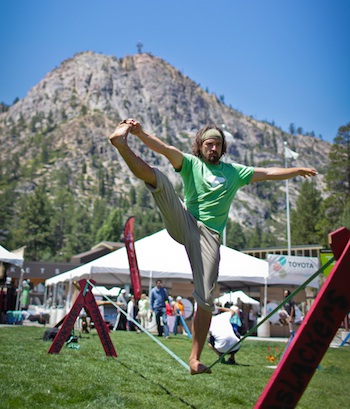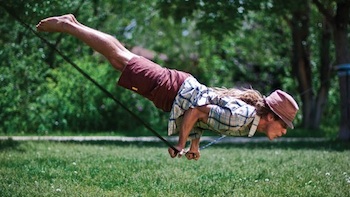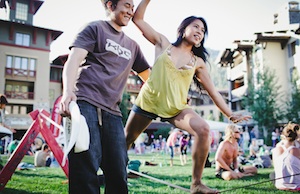 In the realm of extreme sports, slacklining is steadily rising to the top as a dynamic training method for an assortment of athletes and adventurers worldwide. What began as a pastime for rock climbers waiting for the weather to improve has evolved into a well-rounded practice that integrates physical strength, mental acuity, and complete body awareness.
In the realm of extreme sports, slacklining is steadily rising to the top as a dynamic training method for an assortment of athletes and adventurers worldwide. What began as a pastime for rock climbers waiting for the weather to improve has evolved into a well-rounded practice that integrates physical strength, mental acuity, and complete body awareness.
From the simple exercise of balancing on a slack polyester line of webbing, the art of slacklining now incorporates walking long distances — often across lofty, vast canyons — transitioning through yoga-inspired poses, and even introduces moving along the line using variations of vinyasa sequences.
While there are countless advanced practitioners and athletes who compete in this discipline, the eccentric group of adventure junkies known as Team Yogaslackers offers some of the most refined techniques and expertise in the slackline community. They blend the wisdom of yoga and their love for adventure with an intense desire for self-discovery.
A well-known phrase in the Yogaslackers handbook (by James A. Frouden) states, “experience teaches slowly and at the cost of mistakes.” The techniques and awareness around slacklining that Yogaslackers co-founders Sam Salwei and Jason Magness learned took seasons of personal experimentation and countless attempts before they began to understand and relate to the slackline. Now they impart this knowledge to students and enthusiasts in a more concise, approachable manner.
One of the most obvious things people notice when they approach a slackline is the incredible amount of movement reverberating through the webbing. Once they place their foot on the line, their energy transmits directly into it. This isn’t the case for all types of lines; there are now a multitude of line setups, some which have an enormous amount of tension, like long lines and trick lines, and others that have absolutely no tension at all, such as rodeo lines.
What students don’t often realize is that traditional slacklines are nearly void of energy. “This practice has become less about balancing,” says Magness, “because everything in life is always changing. It’s about redefining balance to allow change to happen and to integrate a whole slew of new skills, strength, and sensitivity in order to transcend physical and emotional boundaries. So before you begin to redefine balance, you have to find it.
When Magness stepped onto a slackline for the first time, he was not at all successful at finding his balance. “Slacklining is good for finding out where balance comes from,” he says. “It helps you find your bandhas, those locks in the abdomen and perineum that stimulate energy. After practicing Ashtanga Yoga for three years, Magness developed a keen awareness of the miniscule muscles that form the core and the lower abdomen, which are, he says, “crucial for balancing on the line.”
Ravenous for challenge, Jason and Sam quickly progressed the art of walking on the line, incorporating more complex movements and variations of traditional yoga postures. There are a few major principles that the Yogaslackers teach alongside basic static skills on the line: Kneeling poses use the core to initiate movement and develop coordination throughout the body—coordination that originates from the center. The core integrates strength and stability, allowing the musculature of the body to fully engage through a range of subtle fluctuations.
Standing on the line requires bold commitment and an awareness of the body in space. Standing creates an opportunity to ground down into your feet and trust your legs to support your spine. Sitting on the line offers a place to practice stillness with feet lifted off the ground. Focus and steady breathing translate to comfort and ease on the line. Work intensifies as you balance using the arms instead of the feet. Arm balances require fluidity in breath and combined engagement of the core and hips.
Incorporating pranayama into the practice is vital. Without breath awareness, slacklining becomes very difficult. Emotions inflate, balance decreases, and you lose everything you’ve tried to establish. “There’s a wide spectrum to learning and practicing slacklining,” says Magness. “Lying down demands a lot of stillness in mind and body, while basic line inversions demand a lot of core stability and body awareness.”
MOVING BEYOND SKILLS
Compared to the development of yoga today, slacklining is still a novelty. Magness and his wife Chelsea train and teach together around the world. For them, there are many different goals, with the main one being just to be on the line. “To learn how to cultivate a new relationship on a line with dynamic energy,” Magness says, “is like learning how to walk again.”
 He describes slacklining as the real culmination of self-practice since every movement is an opportunity for self-teaching even in class settings. According to Jason, “The line is a reflection of yourself. We can offer all sorts of forms and tricks, but ultimately it comes down to self-discovery and creative expression.”
He describes slacklining as the real culmination of self-practice since every movement is an opportunity for self-teaching even in class settings. According to Jason, “The line is a reflection of yourself. We can offer all sorts of forms and tricks, but ultimately it comes down to self-discovery and creative expression.”
There’s a sense of freedom in slacklining that is different from the container of the yoga community. It gives structure to “what yoga is” and “how to do it.” If you fall over in triangle pose in a studio, you might be embarrassed. If you fall off the slackline, it means you’re actually exploring. Jason laughs when he comments, “I completely have to let go of any expectations of what a “good” or “right” pose looks or feels like, because in a photo it might look amazing. It’s less about right and wrong and more about how it feels. You have to be so tapped into the line internally, otherwise you’ll fall off.”
Jason and Chelsea’s slackline training is ever-evolving, and the horizon promises new material for them to rehearse. “I wanted to teach Chelsea how to chop logs for the winter season at our home in Bend, Oregon. So we created a training game by carrying logs across a new slack chain in our yard before we were able to chop them. The learning curve was intense, but it opened up new skills and awareness for both of us, and even after seven years of practice I’m learning every time I walk the line.”
The Yogaslackers will be at many of the festivals this summer, including: Shakti Fest, Yuba River Retreat, South Bay Yoga Conference, Yosemite Slacklining and Acro Yoga Retreat, Wanderlust Festival, and All Girls US Slackline Festival. For more information and a full schedule, visit: yogaslackers.com.
For weekly slackline jams and classes in Long Beach, connect at: facebook.com/yogaslackersLA/Longbeach.
Britta Turner strings together farmers, foodies, yogis, artists, and the like. A writer and yoga teacher in San Diego, she weaves her whimsical story together in colorful words and playful movements: brittarael.com. Twitter: @brittarael
Images by Jack Elliott with JVE Photography

